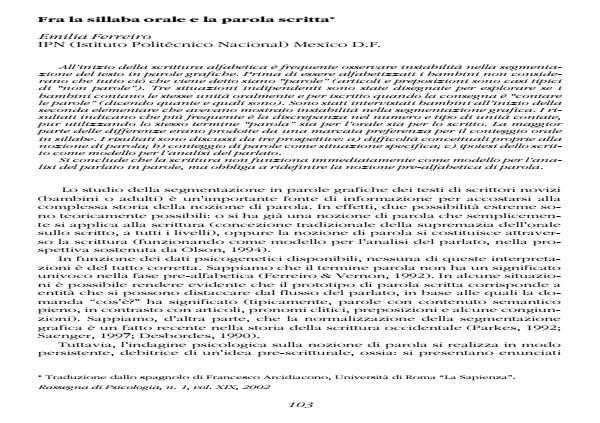Fra la sillaba orale e la parola scritta
Journal title RASSEGNA DI PSICOLOGIA
Author/s Emilia Ferreiro
Publishing Year 1 Issue 2002/1
Language Italian Pages 8 P. File size 68 KB
DOI
DOI is like a bar code for intellectual property: to have more infomation
click here
Below, you can see the article first page
If you want to buy this article in PDF format, you can do it, following the instructions to buy download credits

FrancoAngeli is member of Publishers International Linking Association, Inc (PILA), a not-for-profit association which run the CrossRef service enabling links to and from online scholarly content.
At the beginning of the alphabetic period it is frequent to observe instability when chil-dren are segmenting a text into graphic words. At a previous period children do not accept as words everything that can be said (articles and prepositions are typically considered non words).Three independent but related experimental situations were designed to ex-plore whether the same kind of units are counted out at the written and at the oral level when the instruction is to count the words (saying how many and which ones). Subjects were children at the beginning of 2nd year of elementary school who still showed instability in graphic segmentation. Results show that the most frequent case is a difference in the num-ber obtained as well as in the units counted, even if the same term word was used in both cases (oral and writing). Differences were mainly due to a preference for counting syllables at the oral level. Results are discussed from three perspectives: (a) the conceptual difficulties of the very idea of word; (b) the specificity of a counting situation; (c) the hypothesis of conceiving writing as a model for the analysis of speech. It is concluded that writing do not act immediatly as a model for the analysis of orality into words. However, writing obliges children to reformulate their pre-alphabetic idea of what a word is.
Emilia Ferreiro, Fra la sillaba orale e la parola scritta in "RASSEGNA DI PSICOLOGIA" 1/2002, pp , DOI: